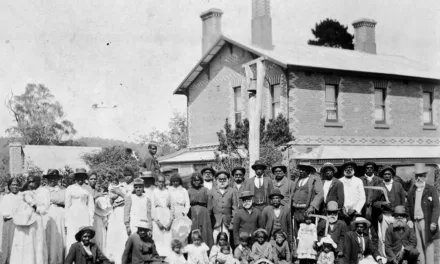Tanya Loos
One of our smaller and rarely seen birds of prey locally is the Grey Goshawk – a funny name as here in Victoria we are very lucky to have the white colour form or ‘morph’. The white morph Grey Goswhak would have to be one of the most beautiful of raptors – indeed it is the only all white bird of prey in the world!
They have snowy white plumage, with bright yellow feet legs and skin just above the beak (their cere). This vivid orange yellow is offset by the dark brown colour of their hooked bill, piercing reddish brown eyes and enormous brown claws on their formidable feet.
Described as a “solitary, secretive hawk of tall, wet and riverine forest”, Grey Goshawks are perch hunters – they like tall dense forest with plenty of protective foliage. They wait silently on their perch, concealed, and then ambush their prey and capture it either on the ground or in the branches. They do not hunt aerially like Peregrine Falcons or conduct high speed chases through the canopy like Brown Goshawks.
And what hunters! They are not all that big, and yet they can tackle prey as large as White-faced Heron, Straw-necked Ibis, kookaburras and currawongs. They eat a lot of parrots and pigeons. About 30-40% of their diet is mammals – Australian Water Rat, other native and introduced rats, Ringtail Possum, antechinus, microbats – and rabbits. Where they still occur, the goshawks prey upon bandicoots and bettongs and other ground living marsupials. They also eat snakes and lizards and plenty of insects in summer.
An all-white bird perched in a tall white gum, such as candlebark, mountain gum is very well camouflaged. Researchers think the white morph recessive gene is selected in the white gum forests of Victoria and Tasmania, whereas the grey morph is better camouflaged in the brighter green and brown barked forests of the central and northeast coast.
This lovely individual was photographed by my friend Gayle Osborne, from Wombat Forestcare, “Driving along Lake Road, Daylesford a white bird lifted off the ground and perched on a power pole. I pulled over and walked back with my camera and was so pleased to see that it was a Grey Goshawk (white morph)”.
Gayle will be keeping an eye out to see if there is a pair locally – as I will! However, there is some dispersal of non-breeding adults and juvenile population in autumn. I checked the sightings on the Birdata platform and there are occasional, scattered records all over this region with a high number of sightings in Ballarat and Linton. (But Ballarat and Linton also have a high number of birdwatchers too!)
Sadly, the Grey Goshawk is listed as Endangered under Victoria’s Flora and Fauna Guarantee Act (1988). These beautiful and fierce raptors need complex dense forest, with abundant prey to survive and thrive. There is talk that this year we will at last hear the long-awaited announcement of the Wombat-Lerderderg National Park – not a moment too soon for the many threatened and special species of the Wombat Forest and surrounds.
Some links:
Fantastic overview of the Grey Goshawk in Victoria: https://www.swifft.net.au/cb_pages/sp_grey_goshawk.php
Wombat Forestcare – I highly recommend their newsletter available here: https://www.wombatforestcare.org.au/
References: https://hanzab.birdlife.org.au/
Tanya Loos is a local naturalist, author and environmental consultant who loves to work in the environmental not-for-profit sector. She is the author of “Daylesford Nature Diary” available from her website or from Paradise Books in Vincent Street, Daylesford.
Have you got any nature questions for Tanya? Send them in!





